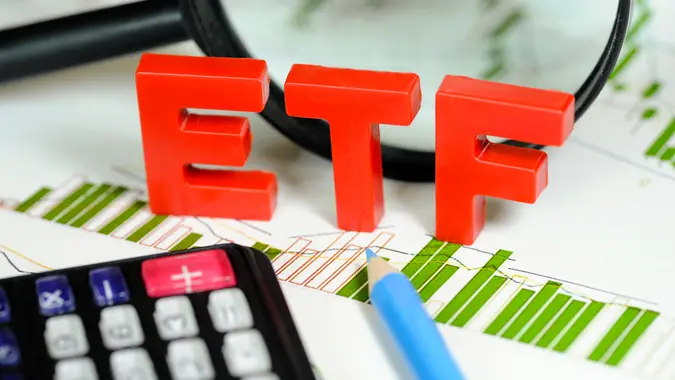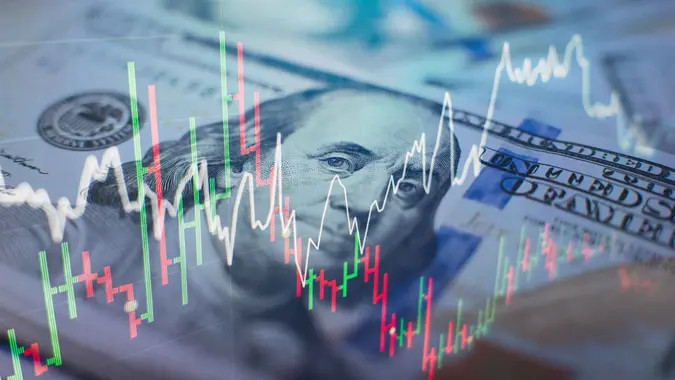How to Sell Bitcoin or Crypto: A Complete Guide

Commitment to Our Readers
GOBankingRates' editorial team is committed to bringing you unbiased reviews and information. We use data-driven methodologies to evaluate financial products and services - our reviews and ratings are not influenced by advertisers. You can read more about our editorial guidelines and our products and services review methodology.

20 Years
Helping You Live Richer

Reviewed
by Experts

Trusted by
Millions of Readers
Whether they’re cashing out their holdings to harvest profits, to shift investments or simply because they need money, people who own Bitcoin or other cryptocurrencies have four ways to sell — through exchanges, P2P marketplaces, crypto ATMs or third-party payment services.
It’s crucial to understand the difference so you can pick the safest and most cost-effective method.
The following article breaks down those methods, offers tips for increasing security and reducing costs, and provides answers to frequently asked questions.
Different Methods to Sell Bitcoin or Crypto
Here’s a look at the four primary ways to sell Bitcoin and other cryptocurrencies.
Using Cryptocurrency Exchanges
Centralized cryptocurrency exchanges like the popular Coinbase, Binance and Kraken platforms are user-friendly, reliable and provide high liquidity. Some also let users leverage their holdings for margin trading.
However, exchanges charge transaction fees, which can be steep. Also, they’re vulnerable to hacking and other exploitations and withdrawal processing times can be slow. Also, most are custodial platforms that hold your assets instead of allowing users to control them in their own wallets with their own keys.
Peer-to-Peer (P2P) Marketplaces
Decentralized exchanges, or P2P marketplaces, like ByBit and KuCoin, use smart contracts to facilitate direct transactions between individual buyers with no third-party go-between. They offer lower fees, increased privacy and expanded asset diversity while allowing users to retain custody of their holdings and keys.
However, their interfaces are often less user-friendly and harder to navigate, particularly for novices, they have lower liquidity and don’t facilitate fiat currency payments or withdrawals.
Bear in mind that many online criminals request p2p crypto transactions as “payments” in the phishing scams and other frauds they commit.
Bitcoin or Crypto ATMs
Bitcoin ATMs (BTMs) are physical kiosks that link to crypto wallets instead of bank accounts, convert cash deposits to crypto holdings and process transactions on the blockchain. Like cash ATMs, they’re designed to provide convenience and accessibility, but they come with risks and limitations.
Their fees are typically higher than for exchange-based or p2p transactions and accessibility is limited. According to Coinbase, 90% of the world’s 30,000 BTMs are in North America, most of which are in the U.S. — but they’re found mostly in specialty shops or cafes and transit centers like airports and train stations.
Follow these steps to sell crypto through a BTM
- Connect your digital crypto wallet, usually via a QR code
- Input how much crypto you want to sell.
- Confirm the sale and receive the sale amount in cash from the BTM.
Third-Party Services
Some payment apps make selling crypto simple. For example, on the PayPal app:
- Navigate to the “crypto” section of your account and tap “sell.”
- If it’s your first time, confirm your tax information
- Input the amount you want to sell and click “next.”
- Tap “sell now” to convert the specified amount of your crypto holdings to cash in your PayPal account.
However, PayPal and similar third-party providers charge transaction fees that can be higher than the more competitive rates that are typical to exchanges.
How to Withdraw Bitcoin or Crypto as Cash
Only a BTM can put physical cash in your hand immediately following a crypto sale. Otherwise, choose one of the following two options.
Bank Transfers
Here’s how to convert digital crypto holdings to money in the bank.
- Link an external bank account to your exchange, p2p platform or digital wallet.
- Complete the sale on your platform of choice.
- Convert your holdings to currency, if necessary.
- Review the transaction and any associated fees, which vary by platform and fluctuate according to transaction size and network traffic.
- Submit a transfer request to your bank account.
PayPal or Other Payment Platforms
PayPal is the most prominent payment platform that supports crypto transactions. Others — which operate similarly but have their own processes and fees — include Venmo, Bitpay and Coingate.
Comparing Selling Methods
| Centralized exchanges | P2P marketplaces | Bitcoin ATMs (BTMs) | Third-party services | |
| Fees | Higher than P2P but lower than BTMs and third-party services. | Low | High | High |
| Convenience | Convenient and user-friendly | Harder to navigate and less intuitive | Easy to navigate, but not widely available | High level of in-app convenience. |
| Speed | Chain-matching systems complete transactions faster than p2p networks, which rely on the blockchain for every transaction. | Slow compared to centralized exchanges | Almost instant | Cash from crypto sales is typically available in PayPal or a similar third-party account within seconds. |
| Security | Vulnerable to hacking and other exploitation | Safe in-platform since users retain custody, but criminals often request p2p crypto transactions in phishing scams and other frauds. | Less anonymity and increased vulnerability to hacking. Also, like standard ATMs, transactions can make users vulnerable to physical robbery. | PayPal Buyer Protection does not cover crypto. However, the platform covers losses to unauthorized activity, provided the user adheres to the platform’s terms and conditions. Similar platforms offer similar mixed-bag coverage. |
Can You Sell Crypto but Keep Some on the Exchange?
Many platforms allow users to sell fractional sales, similar to partial-share investing in stock investing. Instead of selling an entire $83,000 Bitcoin, for example, a user could sell a specific dollar amount — say, $1,500 — and keep the rest on the exchange.
Some use partial sales to harvest a portion of their profits while keeping some of their holdings in play. Others do it to satisfy immediate financial needs without liquidating their entire holding. Others might conduct partial sales to reallocate some, but not all of their crypto holdings to another type of investment.
No matter the reason, partial sales provide added flexibility.
Tips for Beginners When Selling Bitcoin or Crypto
Novices considering their first sale should start small with modest amounts to learn the process with less on the line. Another key is research. Make sure you understand all fees, risks and transaction times before you complete the process — and always stick with trustworthy platforms.
Our in-house research team and on-site financial experts work together to create content that’s accurate, impartial, and up to date. We fact-check every single statistic, quote and fact using trusted primary resources to make sure the information we provide is correct. You can learn more about GOBankingRates’ processes and standards in our editorial policy.
- Stilt. 2022. "How to Turn Bitcoin into Cash."
- Bitpanda. "The difference between a cryptocurrency broker and an exchange."
- Bankless Times. 2023. "How to Sell Cryptocurrency in 2023."
- CNBC. 2022. "From Whole Foods to Gamestop, here are 5 retailers that accept crypto—but there’s a catch."
 Written by
Written by  Edited by
Edited by 

























